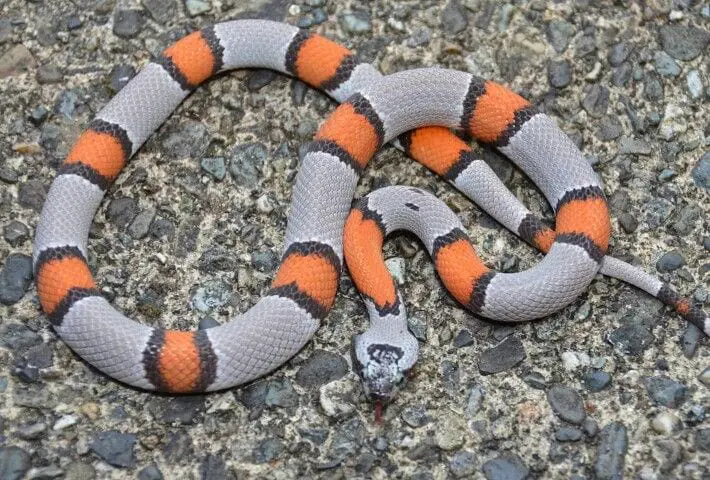
Description:
Scientific name: Lampropeltis alterna
Life span: About 20 years
The gray-banded kingsnake (Lampropeltis alterna), also known as the Davis Mountain king snake or the alterna, is a species of non-venomous snake in the Colubridae family. The gray-banded kingsnake is a medium-sized snake that can reach lengths of up to 4 feet (120 cm) (including the tail). The average total length is 3 feet (91 cm). In comparison to other kingsnake species, it has a comparatively wide head and big eyes with circular pupils.
There are two main color morphs of L. alterna that were originally thought to be different subspecies: the “blairi,” which has wide red/orange banding, and the “alterna,” which has thinner orange/red banding. L. alterna’s colors and patterning vary widely. Both typically have a gray backdrop with accents of white and/or black.
Native Region/Habitat
The Trans-Pecos/Chihuahuan Desert region of southwestern Texas, southern New Mexico, and northern Mexico is where you can find Lampropeltis alterna. The species is closely related to volcanic and limestone soils, as well as steep slopes and typical desert vegetation.

Behavior:
The gray-banded kingsnake is not frequently found in the wild. Although it is a common species, it is nocturnal and quite elusive. Its natural range is sparsely occupied by humans, and because of the steep terrain, many areas are practically impassable. Finding this snake in the wild is frequently praised in the world of field herpetologists. The majority of those that have been found are along the roads that cut across their habitat in the Trans Pecos region. L. alterna tends to be peaceful and is not prone to biting or other defensive behaviors. They are non-venomous and immune to the venom of rattlesnakes.
Care As a pet/In captivity:
Enclosure: A cage that is 3 feet by 2 feet by 2 feet may accommodate an adult Gray Banded Kingsnake. Yet you can give them a bigger enclosure. This species is active and will gladly make use of the space you provide. To assist juveniles and hatchlings, a smaller enclosure should be provided. For young children, a set up of 2 feet by 1 foot by 1 foot works nicely. Plastic tubs can be used to hold hatchlings since they provide security and assist to lessen stress.
Temperature: The Grey Banded Kingsnake prefers a hot location of about 85 degrees Fahrenheit. The enclosure’s ambient temperature can fall as low as 75°F. You can let the temperature in the room drop to about 70 degrees Fahrenheit at night as long as you raise it again in the morning.
Humidity: Because the Grey Banded Kingsnake inhabits a dry, arid environment, low humidity levels are ideal. Maintain adequate airflow and keep the water dish far from the enclosure’s heat source. This usually keeps the humidity level low enough. You can buy a dehumidifier to lower the humidity in the room if the humidity where you live is really high.
Feeding: You can give your Gray Banded Kingsnake a diet made up solely of frozen, thawed mice or rats while it is kept in captivity. The size of the prey item shouldn’t be greater than the snake’s circumference at its broadest point. Adults can be fed less frequently, unless you are getting them back up to weight after breeding, whereas hatchlings should be fed every 5-7 days. Adults can typically be fed a suitable-sized meal every seven to ten days.
Table





